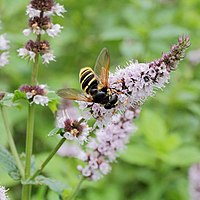
Photo from wikipedia
HighlightsThe Page model best predicted the drying rates of mint leaves in thin-layer laboratory experiments under cyclical temperature change and in field experiments using open-air sun drying and Dehytray and… Click to show full abstract
HighlightsThe Page model best predicted the drying rates of mint leaves in thin-layer laboratory experiments under cyclical temperature change and in field experiments using open-air sun drying and Dehytray and Dehymeleon solar dryers.The total time for drying mint leaves with all solar drying methods was the same (48 h).For all drying methods, the aerobic bacterial count was significantly less on dried mint leaves than on fresh leaves.Color change was less impacted by sunlight with the Dehymeleon than with the Dehytray and open-air sun drying.Abstract. The drying kinetics and quality attributes of mint leaves (Mentha spitaca) were studied to determine the drying performance of two solar drying technologies (Dehymeleon V.2 and Dehytray) and their effect on dried mint quality. Field drying experiments were carried out under weather conditions at Purdue University, West Lafayette, Indiana. Thin-layer laboratory drying experiments were conducted for whole mint leaves at three temperatures [24°C (75°F), 35°C (95°F), and 54°C (130°F)] and airflow velocity of 1 m s-1 to determine the drying kinetics for the diurnal cycles typical for solar drying. The Page model was the most suitable model to predict the drying behavior of mint leaves for both the lab and field experiments. Even though the drying rate was higher with open-air sun drying on uncovered Dehytrays than with covered Dehytrays and the Dehymeleon, the total drying time for all methods was the same (48 h). Color change in mint leaves was less impacted by sunlight for mint leaves dried using the Dehymeleon, while the Dehytray and open-air sun drying had similar results due to their exposure to direct sunlight. For all drying methods, the aerobic bacterial count was significantly less for dried mint leaves than for fresh mint leaves. The log reductions in aerobic bacterial count achieved with open-air sun drying, Dehymeleon, and Dehytray were 0.47, 2.3, and 0.40, respectively. Keywords: Diffusion, Drying kinetics, Food quality, Mint leaves, Solar drying, Sun drying, Thin-layer drying.
Journal Title: Transactions of the ASABE
Year Published: 2021
Link to full text (if available)
Share on Social Media: Sign Up to like & get
recommendations!